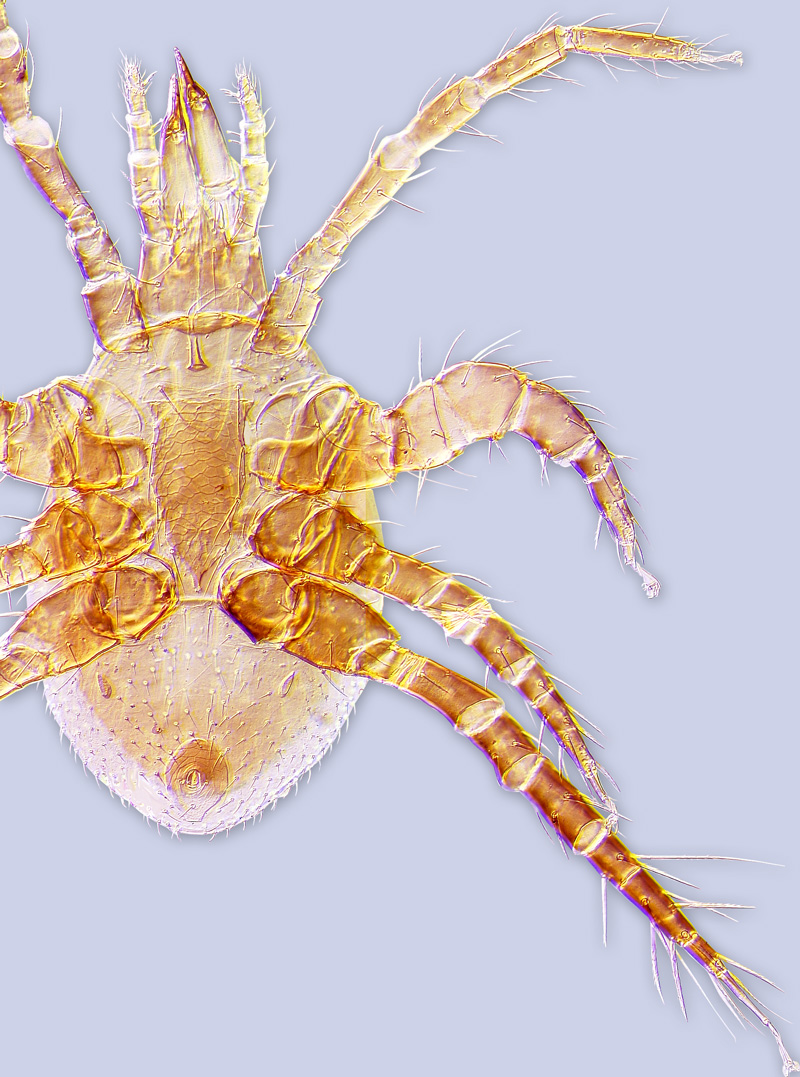Bee Mites : Acari : Parasitiformes : Mesostigmata : Parasitidae
Genus Parasitellus Willmann, 1939
Parasitellus Willmann, 1939: 534 (Type species Eugamasus (?) ferox Tragardh, 1910 = Acarus fucorum De Geer, 1778 by original designation); Hyatt, 1980: 327 (his synonymy).
Parasitus (Parasitus) non Latreille, 1795: Tichomirov, 1977: 60.
Parasitus non Latreille, 1795: Richards, 1976: 732 (part.); Karg, 1985: 525 (part.).
Type speices Eugamasus (?) ferox Tragardh, 1910 = Acarus fucorum De Geer, 1778 by original designation
Material (show database records).
General Description. This genus includes 11 species that inhabit nests of bumblebees (Bombus) in the Holarctic region (Davydova, 1988; Hyatt, 1980; Karg, 1985; Richards, 1976). Occasionally they occur in beehives or burrows of small mammals (Hyatt, 1980; Crozier, 1989). Deutonymphs are commonly phoretic on the adult bumblebees or cuckoo bumblebees. Since bumblebee colonies are annual and only young queens overwinter, mite deutonymphs are able to distinguish between queens and other castes (workers, males). Although the mites may disperse on all castes of bumblebees, they prefer queens, and never move from a queen to a male. Mites dispersing on workers and males may try to switch to queens later, either during copulation or on flowers, where bumblebees forage (Huck et al., 1998; Schwarz and Huck, 1997).
The species of Parasitellus, although only associated with bumblebees, are not specific to a particular species of host, with species often co-occurring in individual Bombus nests. The lack of host specificity in this group may be the result of host switching in flowers by cockoo bumblebees, or by queens that visit old nests with overwintered deutonymphs. In the nests of a single bumblebee species, mites can disperse due to queen supersedure or invasion of workers or queens from different nests (Richards and Richards, 1976; Tichomirov, 1969a).
The exact nature of the association between these mites and their bumblebee hosts is uncertain, although predatory behavior toward acarid mites and other parasitid mites was suggested (Richards and Richards, 1976). If these mites feed preferentially on potentially damaging acarid mites, they may be beneficial to colony health. In Parasitellus fucorum, males, larvae, protonymphs, and possibly deutonymphs were found to be predatory under laboratory conditions, while pollen was the preferred food for adult females and deutonymphs (Koulianos and Schwarz, 1999).
Variation in many species of Parasitellus involves asymmetry in the shape of the tectum.
Distribution (show map).
Species included.
- Parasitellus arcticus (Karg, 1985) [Bombus]
- Parasitellus crinitus (Oudemans, 1903) [Bombus]
- Parasitellus fucorum (De Geer, 1778) [Apis Bombus]
- Parasitellus hobbsi (Richards, 1976) [Apis Bombus]
- Parasitellus ignotus (Vitzthum, 1930) [Bombus]
- Parasitellus inquilinobombus (Richards, 1976) [Bombus]
- Parasitellus jamalensis Davydova, 1988 [Bombus]
- Parasitellus netskyi (Davydova and Bogdanov, 1976) [Bombus]
- Parasitellus nr. crinitus (Oudemans, 1903) [Apis]
- Parasitellus nr. perthecatus (Richards, 1976) [Apis]
- Parasitellus nr. talparum (Oudemans, 1913) [Apis]
- Parasitellus papei Karg, 1985 [Bombus]
- Parasitellus perthecatus (Richards, 1976) [Bombus]
- Parasitellus sp1 Crozier, 1989 [Apis Bombus]
- Parasitellus sp Klimov (unpubl.) [Bombus]
- Parasitellus talparum (Oudemans, 1913) (=Parasitus anglicus Vitzthum 1930; Parasitus bombophilus Vitzthum 1930; Parasitus numismaticus Vitzthum 1930; Parasitus favus Richards, 1976; Parasitus traegardhi Micherdzinski, 1969; Parasitus crinitosimilis Vitzthum, 1930) [Bombus]
Key to species of the genus Parasitellus from North America
deutonymphs*
|
| 1 | Tarsus I not divided ... Parasitellus inquilinobombus
|
|
- | Tarsus I divided |
|
|
2(1) | Opisthonotal shield with more than 20 pairs of setae. Tectum with tapered middle point. Apex of tarsus II with 2 lateral spines. Basitarsus IV with 1 long seta (about twice as long as other tarsal setae) ... Parasitellus talparum
|
|
- | Opisthonotal shield with less than 16 pairs of setae. Tectum with rounded or slightly tapered middle point. Apex of tarsus II with filiform setae. Basitarsus IV with or without long seta |
|
|
3(2) | Basitarsus IV without long setae. Metapodal shields comma-shaped. Sternal setae smooth. ... Parasitellus hobbsi
|
|
- | Basitarsus IV with 1 long seta (about twice as long as other tarsal setae). Metapodal shields oval or pear-shaped. Sternal setae serrate or smooth |
|
|
4(3) | Opisthonotal shield with rounded posterior end and slightly convex lateral edges. Sternal shield narrower (Fig. 1), without longitudinal striations. Sternal setae serrate, sternal setae ST1-3 not inflated at bases ... Parasitellus perthecatus
|
|
- | Opisthonotal shield triangular. Sternal shield broad, with scarce longitudinal striations. Sternal setae smooth, sternal setae ST1-ST3 distinctly inflated at bases ... Parasitellus sp ex Bombus diligens (Mexico)
|
* Crozier (1989) lists four unidentified Parasitellus species from bee hives in Nova Scotia (Canada): P. nr. crinitus, P. nr. talparum (as P. favus), P. nr. perthecathus, and P. sp5. Davis and McRory (1987) reported "Parasitus sp. that is not one of the native species" for Canada. This material is not included in the key because it has not been yet studied. Parasitellus papei Karg, 1985 (Greenland) and Parasitus arcticus Karg, 1985 (female only) (Greenland) also should be included here.
References
Davis, A. & D. MacRory. 1987. Various mites from Ontario beehives. Canadian Beekeeping.13: 209.
Koulianos, S. & H. H. Schwarz. 1999. Reproduction, development and diet of Parasitellus fucorum (Mesostigmata : Parasitidae), a mite associated with bumblebees (Hymenoptera: Apidae). Journal of Zoology.248: 267-269.
Image Gallery
B. OConnor and P. Klimov ©
Created: April 24, 2012
Last modified: 

